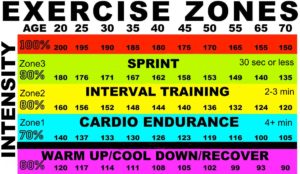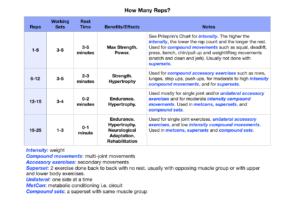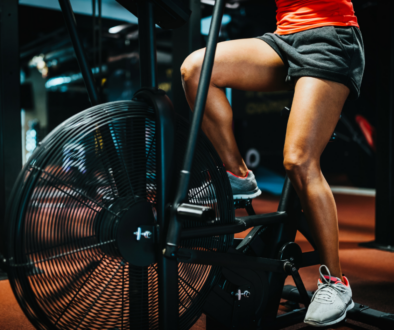Training Variables: The Recipe for Success
In training, a program is like a recipe and training variables are the ingredients. Just as following a recipe will make a great meal in the kitchen, following a training program will deliver the results you want at the gym.
Exercise Selection Know your WHY.
What’s your goal? Are you working out for weight loss, weight gain, pain reduction, stress management? Choose the right exercises for your goal. If, for example, you want to improve your upper body posture or alleviate shoulder pain, you’ll prioritize back strengthening over bench press. If your goal is a 300lb deadlift, you’ll spend most of your time practicing heavy deadlifts. And contrary to what you might have been told, the best type of exercise for weight loss is not cardiorespiratory training.
Intensity How hard are you working?
 Intensity is the effort, usually a percentage, based on your maximum. For cardiorespiratory training, intensity is a percentage of your maximum heart rate. Estimate your maximum heart rate with the formula 220 minus your age.
Intensity is the effort, usually a percentage, based on your maximum. For cardiorespiratory training, intensity is a percentage of your maximum heart rate. Estimate your maximum heart rate with the formula 220 minus your age.
For strength training, intensity is a percentage of your one repetition maximum (1RM). If you don’t know or don’t have a 1RM, you can predict it with this calculator.
Work at the intensity that supports your goal. Intensity and volume have an inverse relationship: the harder you work, the less you do and vice versa.
Volume How many reps?
 Volume is the total number of repetitions performed. Prileprin’s Chart can provide a guideline for optimal volume at a given intensity.
Volume is the total number of repetitions performed. Prileprin’s Chart can provide a guideline for optimal volume at a given intensity.
Like intensity, volume will be determined by your goals.
Order First things first.
Go from complex to simple. Start with weightlifting (snatch and clean and jerk) and power lifting movements (squat, deadlift, bench). Then move on to other compound (multi-joint) exercises such as pull ups, rows, overhead presses, step ups, and lunges. Finish up with core and single joint movements such as bicep curls, or calf raises. For strength, weight loss, and general fitness goals, do weights before cardio.
Tempo Need for Speed
There are three phases to a movement: concentric, isometric, and eccentric. During the concentric phase, the muscles are shortening. This is the lifting phase. During the isometric phase, there is no movement. This is the pause at the completion of the lift. During the eccentric phase, the muscles are lengthening against the resistance. This is the negative phase. For most movements, there is a quick concentric lift, a one-count isometric hold, and a slow negative or eccentric phase. This does not apply to heavy deadlifts: there’s no eccentric on a heavy deadlift. Drop that heavy weight and make a lot of noise when you do it.
You can manipulate this variable by adding pauses, speeding up, or slowing down any of the phases. For example, add a 3-count pause in the bottom of a squat or at the knee in the first pull of a snatch or clean. Pauses have a specific purpose, such as reinforcing a position that needs improvement.
Frequency & Duration How long and how often?
For emotional and physical well-being, move every day, but don’t overdo it. Unless you’re a competitive athlete, 30 to 90 minutes maximum is all you need. For the average fitness enthusiast, training two plus hours/day increases your risk for burnout and overtraining. Based on studies, here’s what you need for health improvements:
- 30-minute Strength Training 2x/week
- 30-minute HIIT (High Intensity Interval Training) 1x/week
- 30-minute Moderate Intensity Steady State Cardio 1-2x/week
- 60-minute Moderate Intensity Cardio 1x/week (could be something fun like tennis or Zumba)
- Yoga 2x/week
Rest & Recovery Train hard, rest harder.
Rest is an important part of your training. For endurance training, rest during the workout will be minimal or non-existent as in Steady State cardio. Endurance (a.k.a conditioning) can also be improved with metcons (Metabolic Conditioning). Metcons are short, intense circuits of body weight and/or compound movements (like burpees, box jumps, kettlebell swings, and squats) done with little or no rest.
For Srength training and Interval cardio training (such as sprints), you’ll rest between sets/sprints to allow the ATP (energy in your cells) to replenish.
Training is digging a hole. Recovery is filling it back up.
Recovery between workouts and cycles is super important to avoid hitting a plateau, burning out, and getting injured. Recovery is not, however, sitting on the couch binge watching TV and eating pizza. Recovery is going for a walk, practicing yoga, foam rolling, getting a massage, etc. It’s an active part of your training program that keeps you progressing toward your goals safely and happily.
Exercise Selection, Intensity, Volume, Order, Tempo, Frequency & Duration, and Rest & Recovery are the basic components of programming. Understanding the effects of manipulating each variable and their interdependent relationships are crucial to designing a successful program that will help you reach your goals.
Get the right recipe for your success. Email me about programming!
Alicia Cross is a Certified Personal Trainer, Wellness Coach, and Yoga Instructor with more than 17 years’ experience working with clients in classes and one-to-one. She is a yogi, meditator, vegan, and lifter of heavy things. If you’re ready to discover the strength and peace that comes from within, email Alicia@AliciaCrossTraining.com.
Related Posts:
Are You Training for Health, Fitness, or Performance?
The 5 Biggest Mistakes You’re Making at the Gym
What is Fitness? Part 3: Strength
What is Fitness? Part 1: Cardio




